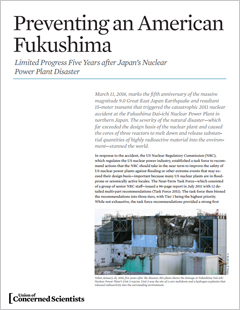In March 2011, a massive earthquake and tsunami triggered a severe nuclear accident at the Fukushima Daiichi nuclear power plant in northern Japan. Three reactors suffered nuclear meltdowns, releasing significant amounts of radiation and stunning a world that had been led to believe that nuclear power was safe .
Following the accident, a task force of senior staff at the U.S. Nuclear Regulatory Commission (NRC) issued a 96-page report, detailing their recommendations for protecting the U.S. public from a Fukushima-scale disaster. Five years later, the NRC—charged with safety at U.S. nuclear reactors—has either rejected or weakened nearly all of its own staff’s recommendations. Of the changes that have been made—including implementation of the so-called “FLEX” program—it remains unclear whether the money and time invested will yield significant safety improvements.
Our recommendations
The Fukushima nuclear disaster wasn’t caused by just an earthquake and a tidal wave—it was also the result of a complacent nuclear power industry and an ineffective regulator. The U.S. response to those eye-opening events has, to some degree, highlighted the very same fundamental problems: industry hasn’t taken nuclear safety as seriously as it should, and the NRC has failed to strengthen its regulatory framework.
We believe the NRC should revisit its post-Fukushima recommendations by adopting the following measures:
- Revise the regulatory framework. The NRC’s current structure works against public safety.
- Expedite the transfer of spent fuel to dry casks. This relatively simple measure could help prevent significant radiation releases.
- Increase emergency planning zone sizes. The current radius of 10 miles doesn’t reflect the actual range of dangerous radioactive fallout released during Fukushima.
- Increase NRC oversight of operator guidelines. Guidelines for reactor management during a core-melt accident are currently maintained voluntarily and aren’t subject to NRC enforcement.
- Validate FLEX strategies. The NRC should stress test the FLEX program to clearly understand and address its limitations.





